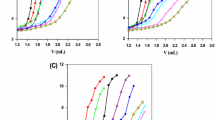Abstract
The stability constants of the 1 : 1 complexes formed between Pb2+ and several simple phosphate monoesters (4-nitrophenyl phosphate, phenyl phosphate, d-ribose 5-monophosphate, n-butyl phosphate) or phosphonate ligands (methylphosphonate, ethylphosphonate) (R-PO2– 3) were determined by potentiometric pH titrations in aqueous solution (25 °C;I=0.1 M, NaNO3). The construction of a log K P P b b(R-PO3) versus pK H H(R-PO3) plot for the mentioned ligand systems results in a straight line on which the data pairs (the corresponding equilibrium constants were also measured) for uridine 5′-monophosphate (UMP2–) and thymidine 5′-monophosphate (dTMP2–) also fall; this result shows that in the Pb2+ complexes of UMP2– and dTMP2– the nucleobase residues do not interfere, in neither a positive nor a negative way, with the binding of Pb2+ and that the stability of all these complexes is determined by the basicity of the phosph(on)ate group. The mentioned straight-line correlation (as defined by the least-squares procedure) allowed us to demonstrate (via constants determined now) that the stability of the Pb2+ complex of cytidine 5′-monophosphate (CMP2–) is also solely determined by the basicity of its phosphate group. A similar evaluation, based on literature data, for the Pb(HPO4) complex reveals that its stability corresponds closely to the expectations based on the Pb(R-PO3) data, though there is a slight hint that Pb(HPO4) may be somewhat more stable [which would be in agreement with previous observations of other M(HPO4) complexes]; clearly, more such comparisons are possible with the reference line given now. Based on the stability constants of the monoprotonated Pb(H;CMP)+ complex and the Pb(cytidine)2+ species (which was also measured now), it is concluded that in Pb(H;CMP)+ the proton is located at the phosphate group and Pb2+ mainly at the N3/(C2)O site of the cytosine residue. Regarding nucleic acids in solution, it is further concluded that the affinity of Pb2+ towards the negatively mono-charged phosphate unit, —O—P(O)2 –—O—, of a nucleic acid backbone is comparable to that of the cytosine moiety, the affinity towards other nucleobase residues being smaller. This information may prove helpful regarding the properties of lead ribozymes.
Similar content being viewed by others
Author information
Authors and Affiliations
Additional information
Received: 16 April 1999 / Accepted: 2 June 1999
Rights and permissions
About this article
Cite this article
Da Costa, C., Sigel, H. Stabilities of complexes formed between lead(II) and simple phosphonate or phosphate monoester ligands including some pyrimidine-nucleoside 5′-monophosphates (CMP2–, UMP2–, dTMP2–). JBIC 4, 508–514 (1999). https://doi.org/10.1007/s007750050336
Issue Date:
DOI: https://doi.org/10.1007/s007750050336




